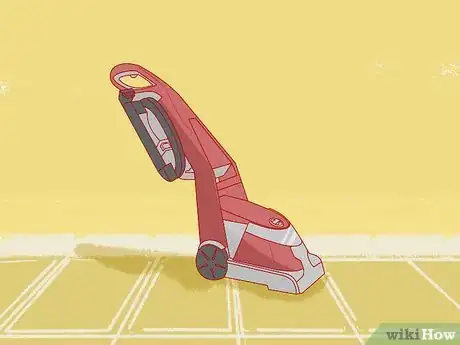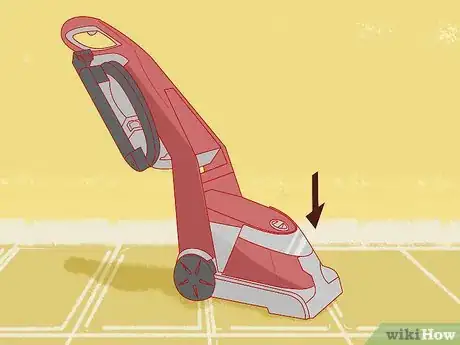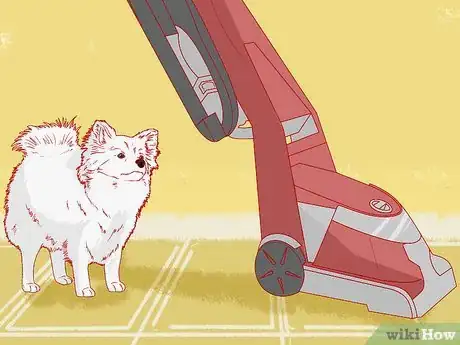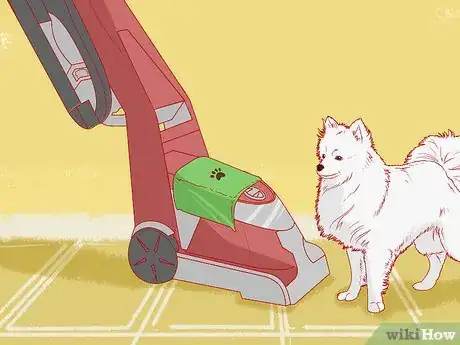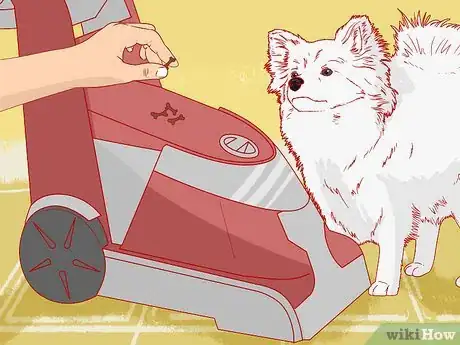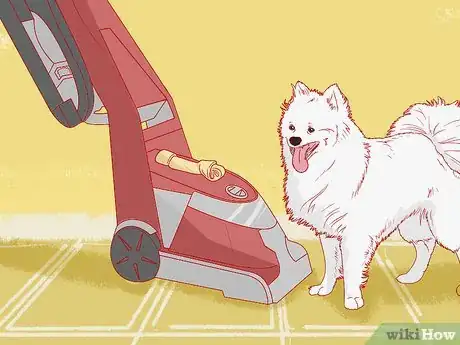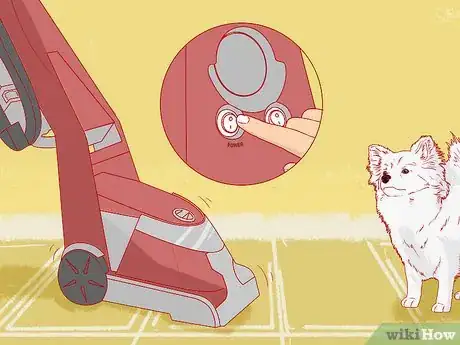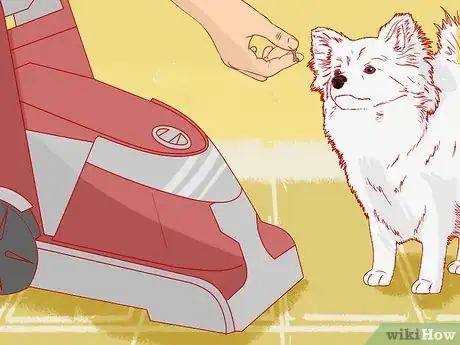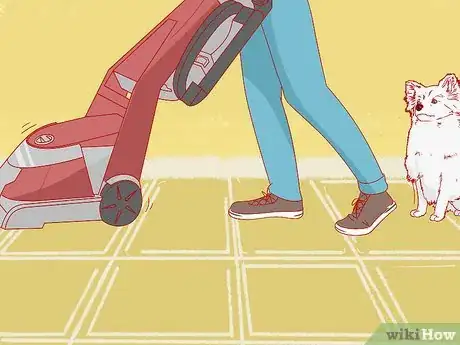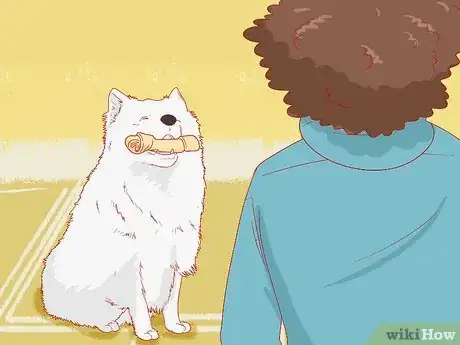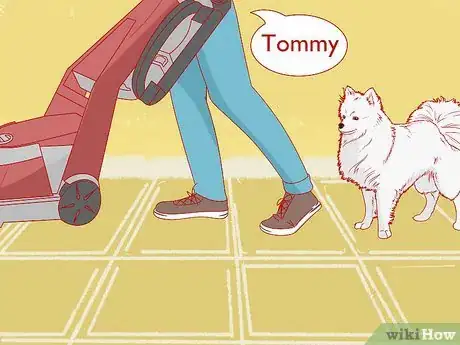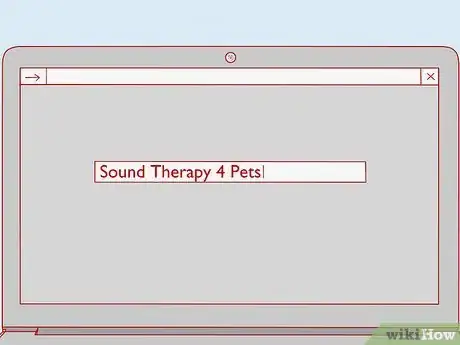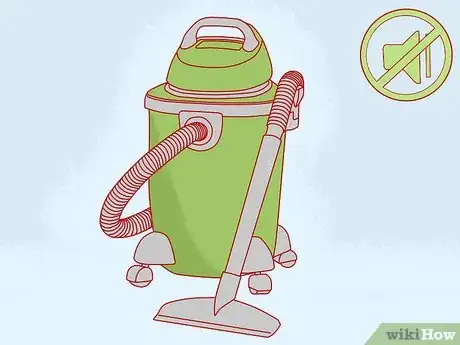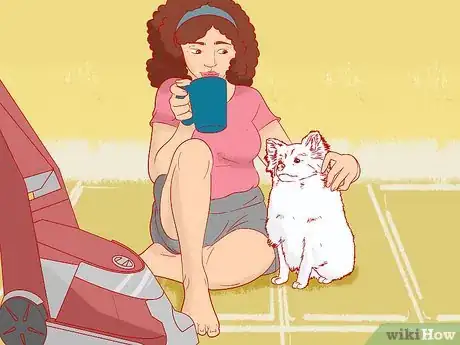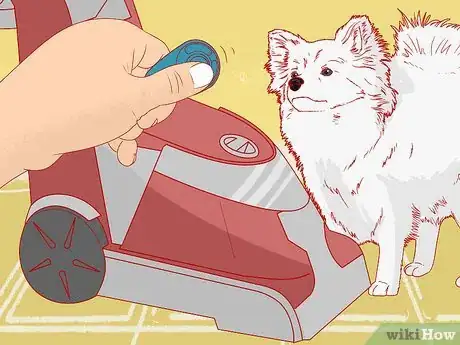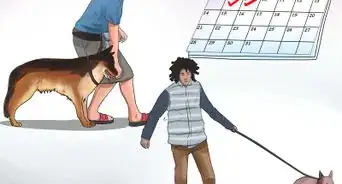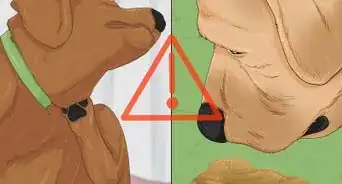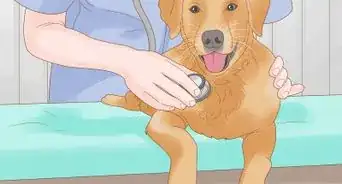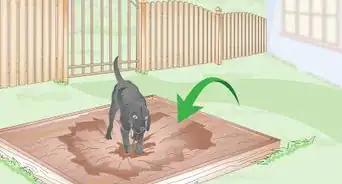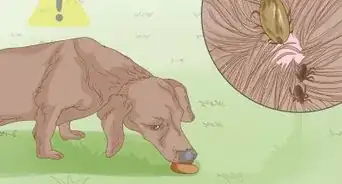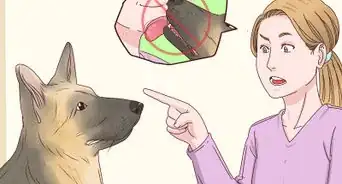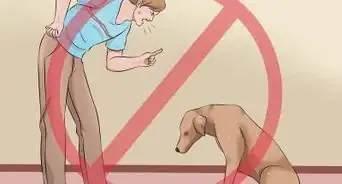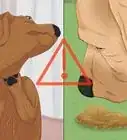This article was co-authored by Elisabeth Weiss. Elisabeth Weiss is a Professional Dog Trainer and owner of Dog Relations NYC, a dog training service in New York, New York. Elisabeth relies on science-based, force-free, and reward-based techniques. Elisabeth offers behavior training, puppy manners, body awareness and injury prevention, diet, exercise and dog nutrition services. Her work has been featured in New York Magazine and on the Dog Save the People podcast. She also trained all the dogs in the movie "Heart of a Dog" by Laurie Anderson that features Elisabeth's journey with Laurie Anderson's and Lou Reed's dog Lolabelle and how her passion for playing the keyboards played a significant role in improving her quality of life after being diagnosed with pancreatic cancer.
This article has been viewed 55,759 times.
Most house pets have a fear of vacuum cleaners. The fact that they are large, and quite noisy, makes this fear understandable. Most pets run away as soon as the cleaner comes out, and cats might even hide under the bed. However, with a little work, you can help your pet overcome its fear of the vacuum cleaner.
Steps
Acclimating Your Pet
-
1Store the vacuum in an open area. When the vacuum cleaner is not in use, place it where your pet can easily see it. Being around the vacuum while it is not making noise should help your pet view the cleaner as something other than a threat.[1]
-
2Keep the vacuum low to the ground. Make sure the vacuum is as close to the ground as possible. Adjust the upright section of the vacuum so that it is lying on the ground or is as close to the ground as possible. Reducing the overall height of the vacuum may make it seem less imposing to a pet.Advertisement
-
3Allow your pet to investigate the vacuum. Move the cleaner to where the pet is sitting while it is turned off and allow the animal to look at and smell it.[2] Pets go by scent as well as sight. Once they get used to seeing and smelling the vacuum, they should naturally be less afraid.[3] [4]
- Never place the vacuum cleaner where your animal likes to sleep or eat. This might only work to make them afraid of those areas, causing further problems.
- If you have a cat that you are trying to acclimate to a vacuum, never place the vacuum by its litter box.[5]
- Reward your pet whenever they show interest in the vacuum.[6]
-
4Make the vacuum more familiar. Try placing a towel or sheet the animal uses on the vacuum cleaner while it is turned off. Your pet may want to get closer to the vacuum because it smells familiar or because it has something the animal wants on top of it.[7]
-
5
-
6Utilize an animal’s toys. Animals can be quite territorial when it comes to their favorite toys. Take a toy you know your pet loves and place on the vacuum cleaner while it is off. Over time, the animal may come to associate the vacuum cleaner with one of its play things.[10]
-
7
-
8Keep the vacuum stationary. While the vacuum is on and making noise, leave it in one place. If it is not moving, but still making noise, your pet may choose to be brave and approach the vacuum. At the very least, it may get a little bit closer, signaling a minor victory.[13]
- Be sure to reward your pet for any attempts to get close to the vacuum with treats or toys.[14]
-
9Keep your distance. Try to vacuum at a distance from the animal. Do not go too close while they watch you. After a while, they might be braver and actually follow you around as you vacuum.[15]
-
10Reward the animal after vacuuming. When you finish vacuuming the desired area, turn the vacuum off and offer your pet a treat, toy or reward.[16] If your dog loves going for walks, take him out for a walk immediately after vacuuming. If your cat likes wet food, give it a can when you have finished vacuuming. If you do this consistently, the animal will come to associate the vacuum with activities it enjoys.[17]
-
11Try talking to your pet. Talking to your pet in a calm voice while vacuuming may help it realize that the vacuum is not something to be feared. Animals take verbal and non-verbal cues from their humans. Try calling the pet over to you with a friendly and calm demeanor while the vacuum is running. Its eagerness to follow your commands may be enough to help your pet overcome its fear.
Using Alternative Methods
-
1Look into sound therapy. Have a look at the Sound Therapy 4 Pets website. They have a number of CDs that prepare and treat dogs that have sound phobias. While not always effective, getting your animal used to the sound without the sight of the vacuum could help the animal overcome its fear.[18] [19]
-
2Purchase a quiet vacuum. All vacuums make some noise, but many vacuums are designed to limit and almost eliminate the amount of noise they make. If your pet is really scared of your vacuum, try buying one that isn’t as noisy.[20]
-
3Be patient. While some pets will fear the vacuum cleaner their entire lives, some pets just need to get used to its presence. If you have young pets, simply go through your vacuuming routine as usual. Over time, they may get used to it and lose their fear. [21]
-
4Use clicker training. If your pet has been trained with a clicker, try using the clicker to get the animal used to the vacuum. Start with the vacuum off and click while dropping a treat when the animal comes around the vacuum. Once the animal is close, run the vacuum very briefly and turn it off again. While you are doing this, click and drop a treat for the animal before it has the chance to react to the noise.[22]
- Once the animal has gotten used to the sound of the vacuum, try using the clicker method while moving the vacuum around your pet.[23]
Expert Q&A
-
QuestionHow do you introduce a puppy to a vacuum?
 Elisabeth WeissElisabeth Weiss is a Professional Dog Trainer and owner of Dog Relations NYC, a dog training service in New York, New York. Elisabeth relies on science-based, force-free, and reward-based techniques. Elisabeth offers behavior training, puppy manners, body awareness and injury prevention, diet, exercise and dog nutrition services. Her work has been featured in New York Magazine and on the Dog Save the People podcast. She also trained all the dogs in the movie "Heart of a Dog" by Laurie Anderson that features Elisabeth's journey with Laurie Anderson's and Lou Reed's dog Lolabelle and how her passion for playing the keyboards played a significant role in improving her quality of life after being diagnosed with pancreatic cancer.
Elisabeth WeissElisabeth Weiss is a Professional Dog Trainer and owner of Dog Relations NYC, a dog training service in New York, New York. Elisabeth relies on science-based, force-free, and reward-based techniques. Elisabeth offers behavior training, puppy manners, body awareness and injury prevention, diet, exercise and dog nutrition services. Her work has been featured in New York Magazine and on the Dog Save the People podcast. She also trained all the dogs in the movie "Heart of a Dog" by Laurie Anderson that features Elisabeth's journey with Laurie Anderson's and Lou Reed's dog Lolabelle and how her passion for playing the keyboards played a significant role in improving her quality of life after being diagnosed with pancreatic cancer.
Professional Dog Trainer Let the puppy explore the vacuum while it's completely turned off. Repeatedly reward your pup as they interact with the vacuum; then, turn it on briefly and see how they react. If your puppy is scared, take them a little further away from vacuum and reward them for not reacting.
Let the puppy explore the vacuum while it's completely turned off. Repeatedly reward your pup as they interact with the vacuum; then, turn it on briefly and see how they react. If your puppy is scared, take them a little further away from vacuum and reward them for not reacting. -
QuestionHow do you get a dog to like a vacuum?
 Elisabeth WeissElisabeth Weiss is a Professional Dog Trainer and owner of Dog Relations NYC, a dog training service in New York, New York. Elisabeth relies on science-based, force-free, and reward-based techniques. Elisabeth offers behavior training, puppy manners, body awareness and injury prevention, diet, exercise and dog nutrition services. Her work has been featured in New York Magazine and on the Dog Save the People podcast. She also trained all the dogs in the movie "Heart of a Dog" by Laurie Anderson that features Elisabeth's journey with Laurie Anderson's and Lou Reed's dog Lolabelle and how her passion for playing the keyboards played a significant role in improving her quality of life after being diagnosed with pancreatic cancer.
Elisabeth WeissElisabeth Weiss is a Professional Dog Trainer and owner of Dog Relations NYC, a dog training service in New York, New York. Elisabeth relies on science-based, force-free, and reward-based techniques. Elisabeth offers behavior training, puppy manners, body awareness and injury prevention, diet, exercise and dog nutrition services. Her work has been featured in New York Magazine and on the Dog Save the People podcast. She also trained all the dogs in the movie "Heart of a Dog" by Laurie Anderson that features Elisabeth's journey with Laurie Anderson's and Lou Reed's dog Lolabelle and how her passion for playing the keyboards played a significant role in improving her quality of life after being diagnosed with pancreatic cancer.
Professional Dog Trainer Focus on desensitizing your dog rather than getting them to "like" the vacuum. Keep your dog on a leash and gradually engage them a little bit more with the vacuum. Then, give the pup plenty of treats whenever they don't react.
Focus on desensitizing your dog rather than getting them to "like" the vacuum. Keep your dog on a leash and gradually engage them a little bit more with the vacuum. Then, give the pup plenty of treats whenever they don't react.
Warnings
- Do not tease animals with the vacuum cleaner or make believe you are going to push it onto them. While it might look like fun for you, it truly scares the animal.⧼thumbs_response⧽
References
- ↑ http://www.catbehaviorassociates.com/what-to-do-if-your-cat-is-afraid-of-the-vacuum-cleaner/
- ↑ Elisabeth Weiss. Professional Dog Trainer. Expert Interview. 4 November 2021.
- ↑ http://www.catbehaviorassociates.com/what-to-do-if-your-cat-is-afraid-of-the-vacuum-cleaner/
- ↑ https://www.youtube.com/watch?v=CCNAv5aETho
- ↑ http://www.catbehaviorassociates.com/what-to-do-if-your-cat-is-afraid-of-the-vacuum-cleaner/
- ↑ Elisabeth Weiss. Professional Dog Trainer. Expert Interview. 4 November 2021.
- ↑ http://www.catbehaviorassociates.com/what-to-do-if-your-cat-is-afraid-of-the-vacuum-cleaner/
- ↑ http://www.catbehaviorassociates.com/what-to-do-if-your-cat-is-afraid-of-the-vacuum-cleaner/
- ↑ https://www.youtube.com/watch?v=CCNAv5aETho
- ↑ http://www.catbehaviorassociates.com/what-to-do-if-your-cat-is-afraid-of-the-vacuum-cleaner/
- ↑ https://www.youtube.com/watch?v=CCNAv5aETho
- ↑ Elisabeth Weiss. Professional Dog Trainer. Expert Interview. 4 November 2021.
- ↑ https://www.youtube.com/watch?v=CCNAv5aETho
- ↑ https://www.youtube.com/watch?v=CCNAv5aETho
- ↑ http://www.catbehaviorassociates.com/what-to-do-if-your-cat-is-afraid-of-the-vacuum-cleaner/
- ↑ Elisabeth Weiss. Professional Dog Trainer. Expert Interview. 4 November 2021.
- ↑ http://www.catbehaviorassociates.com/what-to-do-if-your-cat-is-afraid-of-the-vacuum-cleaner/
- ↑ https://www.youtube.com/user/soundtherapy4pets
- ↑ https://www.dogstrust.org.uk/help-advice/dog-behaviour-health/sound-therapy-for-pets
- ↑ http://www.consumerreports.org/cro/news/2014/05/quieter-vacuum-cleaners-that-blast-away-dirt/index.htm
- ↑ http://www.catbehaviorassociates.com/what-to-do-if-your-cat-is-afraid-of-the-vacuum-cleaner/
- ↑ https://www.youtube.com/watch?v=CCNAv5aETho
- ↑ https://www.youtube.com/watch?v=CCNAv5aETho
About This Article
You can teach your pet not to be scared of the vacuum cleaner by leaving it in open areas of your house when you’re not using it so it becomes used to its presence. Once your pet is used to seeing the vacuum, try turning it on so it can get used to the sound. Leave the vacuum stationary for a few minutes to give your pet the chance to investigate it and see that it’s harmless. After you’re done vacuuming, make sure to give your pet a reward, like a treat or a walk so it makes a positive association with the vacuum. To learn how to use sound therapy CDs to help your pet overcome its phobia, read more from our Veterinary co-author.
